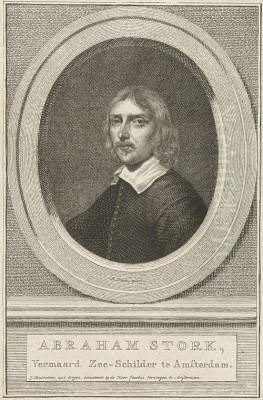
Abraham Storck stands as a significant figure in the rich tapestry of Dutch Golden Age art. Active during the latter half of the 17th century, he carved a niche for himself primarily as a painter of marine subjects, bustling harbour scenes, and evocative landscapes. His work captures the dynamism of the Netherlands' maritime power while also indulging in imaginative depictions of faraway shores. Based in Amsterdam for most of his life, Storck's artistry reflects both the technical brilliance and the thematic concerns of his time.
Biographical Sketch and Verification of Dates
Abraham Storck was born in Amsterdam, baptized on April 17, 1644. He passed away in the same city and was buried on April 8, 1708. These dates are consistently verified across multiple historical sources, establishing the timeframe of his life and career firmly within the Dutch Golden Age. His contributions to art occurred during a period of immense cultural and economic flourishing in the Dutch Republic, particularly in Amsterdam, which was a major global hub for trade and shipping.
A Family of Artists
Storck hailed from a family deeply rooted in the arts. His father, Jan Jansz Sturck (sometimes referred to as Sturckenburch), was a respected painter. Abraham also had brothers, Johannes and Jacobus (or Jacob) Sturck, who pursued artistic careers. Jacobus Storck, in particular, became a notable painter in his own right, often collaborating with Abraham. This familial environment undoubtedly provided Abraham with foundational artistic training from a young age, immersing him in the techniques and traditions prevalent among Amsterdam painters. The shared profession likely fostered a supportive, albeit potentially competitive, atmosphere that spurred his development.
Artistic Career and Guild Membership
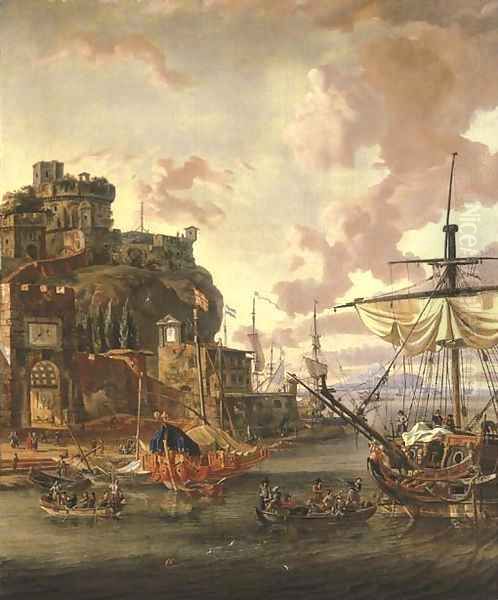
By around 1666, Abraham Storck had established his own independent workshop in Amsterdam. This marked a significant step in his professional life, allowing him to focus on his preferred subjects. He dedicated much of his output to creating detailed naval scenes, lively harbour views, picturesque landscapes, and accurate cityscapes, particularly of his native Amsterdam. His skill and reputation grew, leading to his formal recognition within the city's artistic community. In 1688, records confirm his membership in the prestigious Guild of Saint Luke in Amsterdam, the main organisation for painters and other craftsmen, signifying his status as an established master.
Influences on Storck's Art
Storck's artistic development was shaped by several leading painters of his era. The influence of the renowned marine painters Willem van de Velde the Elder and his son, Willem van de Velde the Younger, is evident in Storck's work. Their mastery in depicting ships with great accuracy and capturing the nuances of the sea and sky set a high standard which Storck clearly studied. His dramatic compositions and attention to nautical detail often echo the Van de Veldes' approach.
Another significant influence was Ludolf Backhuysen, a contemporary marine painter also based in Amsterdam, known for his dramatic seascapes, often depicting rough weather and stormy seas. Storck adopted some of Backhuysen's techniques for rendering light, atmosphere, and the dynamic movement of water. Furthermore, the work of Jan Abrahamsz Beerstraaten, known for his winter landscapes and topographical views, but also for Italianate scenes, seems to have inspired Storck, particularly in his imaginative depictions of Mediterranean ports. The Van de Velde family as a whole, being preeminent in marine art, cast a long shadow, and Storck operated within this established tradition while developing his own distinct style.
Artistic Style: Realism and Fantasy
Abraham Storck's style is characterized by a fascinating blend of meticulous realism and imaginative fantasy. When depicting Dutch coastal scenes or views of Amsterdam, his work is marked by topographical accuracy and precise detail. He rendered ships with an expert eye, capturing the specifics of rigging, hull construction, and the way sails catch the wind. His cityscapes accurately portray the architecture and bustling life of Amsterdam's harbours and canals.
However, Storck was equally adept at creating 'capriccio' scenes – fantastical views of Mediterranean ports. These paintings often combine real architectural elements with imagined settings, featuring classical ruins, baroque buildings, and exotic figures alongside meticulously rendered ships. This genre was popular among collectors, offering an escape to sunny, idealized southern climes. Storck excelled in these imaginative compositions, showcasing his versatility.
Technical Skill and Colour Palette
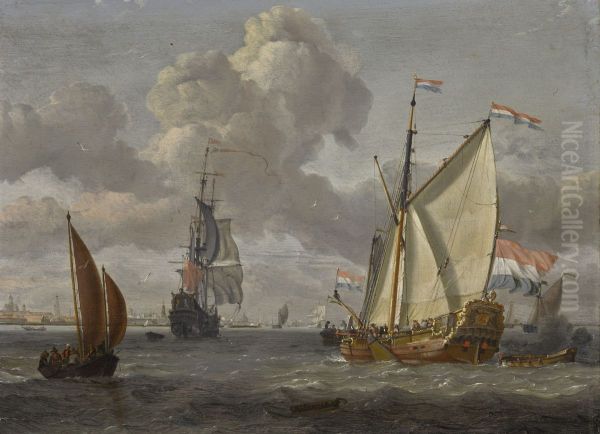
Technically, Storck was a highly skilled painter. His draughtsmanship was precise, evident in the fine lines used to delineate ships and architectural details. He possessed a strong understanding of perspective and spatial composition, creating convincing depth in his scenes. His brushwork could be both detailed and fluid, adapting to the textures he depicted, from smooth water surfaces to rough stone or billowing canvas.
Storck is particularly noted for his use of bright, clear colours. His palette often included vibrant blues for the sky and water, contrasted with the warm tones of ships and buildings. He frequently incorporated touches of pink and gold, lending a luminous, sometimes idealized quality to his scenes, especially the Mediterranean views. His handling of light and shadow was adept, creating atmosphere and highlighting key elements within the composition, contributing to the overall liveliness and visual appeal of his paintings.
Key Themes and Subjects
Marine painting formed the core of Storck's oeuvre. He depicted a wide range of maritime subjects, including specific historical events. He painted naval battles, such as the Four Days' Battle of 1666, a major engagement during the Second Anglo-Dutch War, capturing the chaos and drama of combat at sea. He also depicted ceremonial occasions involving ships, showcasing parades, reviews, or the visits of important dignitaries, often including detailed depictions of the spectators and the festive atmosphere.
His harbour scenes, both Dutch and Mediterranean, are filled with activity, showing ships arriving and departing, cargo being loaded and unloaded, and people going about their business. Beyond purely maritime themes, Storck also painted winter landscapes, often featuring skaters on frozen canals or rivers, a popular genre in Dutch art. His diverse subject matter reflects his broad artistic interests and his ability to capture different moods and settings. The inclusion of numerous small figures, sometimes even self-portraits, adds narrative interest and liveliness to his works.
Representative Works
Several paintings stand out as representative of Abraham Storck's skill and typical subjects. A Capriccio of a Mediterranean Port exemplifies his popular fantasy scenes, showcasing a bustling harbour with elaborate, imagined architecture under a sunny sky, filled with various ships and figures. This work highlights his ability to blend observation with imagination and his use of bright colours.
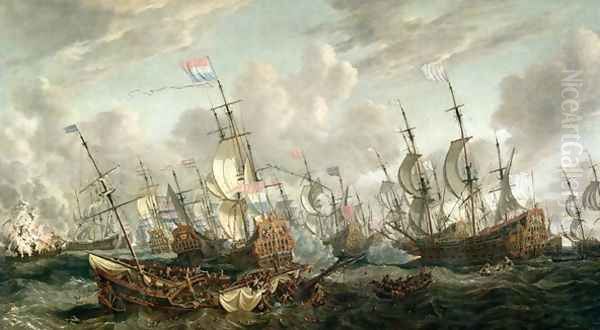
View of Amsterdam with the IJ is a prime example of his topographical work, offering a detailed panorama of the city's waterfront, a testament to Amsterdam's maritime importance. Such views required great accuracy in depicting identifiable buildings and the specific types of vessels present. His painting of the Four Days Battle (1666) demonstrates his capacity for historical marine painting, capturing the intensity of naval warfare. These works, among many others, secure his reputation as a versatile and accomplished master.
Collaboration with Jacobus Storck
Abraham Storck is known to have collaborated with his brother, Jacobus Storck. While both were skilled painters, they appear to have specialized to some extent. Jacobus often focused more on the architectural elements and cityscapes, while Abraham excelled in depicting the ships and marine aspects. Some views of Amsterdam, such as depictions of the Nieuwe Brug, are thought to be joint works. This collaboration highlights the close artistic relationship within the family and allowed them to combine their strengths to produce comprehensive and detailed urban and maritime scenes.
Anecdotes and Unique Aspects
While detailed personal anecdotes about Storck are scarce, his work itself reveals certain unique aspects. His tendency to include lively figures, sometimes engaging in specific activities or ceremonies, adds a narrative and entertaining dimension that goes beyond simple documentation. The inclusion of potential self-portraits within crowded scenes suggests a playful insertion of his own presence into the worlds he created. His dedication to both accurate Dutch views and idealized Mediterranean fantasies showcases a remarkable artistic range, catering to different tastes within the art market of his time. His depiction of historical events like naval battles served not only as art but also as a form of visual record, celebrating Dutch naval prowess.
Art Historical Evaluation and Legacy
In the context of Dutch art history, Abraham Storck is highly regarded. He is often considered one of the last significant marine painters of the Dutch Golden Age, carrying the tradition forward into the late 17th and early 18th centuries. His work successfully synthesized the influences of predecessors like the Van de Veldes and Backhuysen with his own distinct style, characterized by clarity, colour, and often a more decorative or narrative approach.
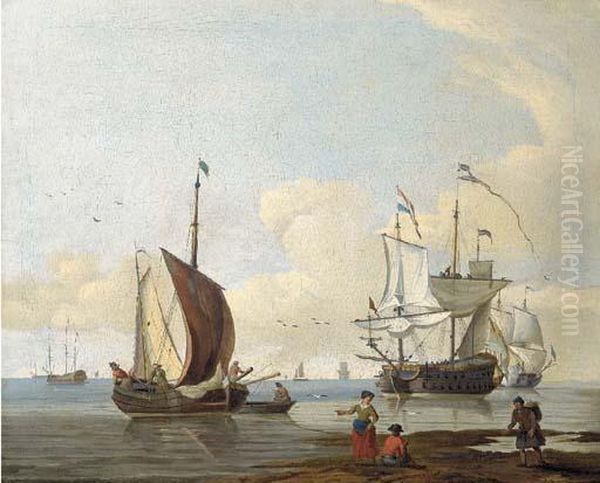
His paintings serve as valuable visual documents of Dutch maritime culture, trade, and naval history. The popularity of his Italianate capriccios reflects the contemporary taste for idealized landscapes and exoticism. Storck's technical proficiency, particularly in the detailed rendering of ships and the vibrant depiction of light and atmosphere, ensured his reputation both during his lifetime and subsequently. His works continue to be held in high esteem and are found in major museum collections worldwide, including the Rijksmuseum in Amsterdam and the Mauritshuis in The Hague. His influence, while perhaps less transformative than that of the Van de Veldes, lies in his skillful continuation and adaptation of the marine genre, leaving behind a rich body of work that captures the spirit of his age.